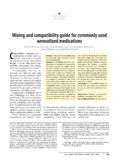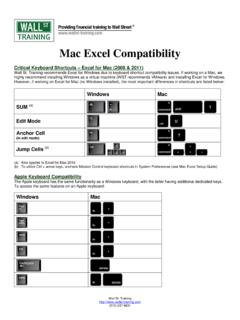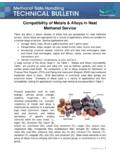Transcription of Why CPVC Pipes Fail Full - californiasprinklerfitters.org
1 Why Do cpvc Pipes fail ? By Dr. Duane Priddy, Plastic Failure Labs, Midland, MI Summary For over 30 years cpvc Pipes have been extensively utilized in fire sprinkler systems due to ease of installation, corrosion resistance, and relatively low failure rate. However, in the past 18 months the failure rate of cpvc Pipes and fittings has increased. Plastic Failure Labs has been extensively involved in trying to determine the cause behind the failure increase. In the past 18 months our investigations indicate that contamination is the root cause of most (>80%) of the failures. The second most common cause of failure is poor installation practices followed by manufacturing defects in Pipes and fittings.
2 Until recently we (like most forensic labs) utilized infrared spectroscopy (IR) for contaminant identification in failed cpvc pipe samples. However, IR was not detecting anything unusual inside the failed Pipes even though the failure mode was clearly environmental stress cracking (ESC) due to contamination on the inside of the Pipes . We therefore explored alternate forensic contaminant identification techniques. We found that GC-MS worked exceptionally well and we successfully developed a protocol for pipe and water sample analysis. Using GC-MS we successfully determined the root cause for the sudden increase in failures of cpvc pipe and fittings; , the main contaminants responsible for most of the ESC failures were amines.
3 In 2008, whenever GC-MS detected amines inside of failed cpvc samples that we analyzed, we discovered that Allied ABF metal pipe was also used in the water supply system. Our discovery of the amines and the Allied ABF source has not been without controversy, primarily because most other forensic labs were not detecting the chemicals. However, we continued to communicate our findings because of our scientific certainty. Currently the controversy is beginning to wane as recent evidence collected by others supports our findings. This article is being written to help educate the Fire Sprinkler Industry about the amine contamination issue.
4 Also we are trying to help educate installers about installation errors and Forensic Failure Scientists about the benefits of GC-MS for contaminant analysis. Introduction Plastic Failure Labs is an independent forensic laboratory. We have been conducting forensic failure analyses for several years. In that time we have carried out hundreds if forensic failure analysis investigations of cpvc fire sprinkler Pipes and fittings at the request of insurance companies, installers, general contractors, condominium associations, and private owners. We have seen everything from hairline branched cracks in Pipes (Figure 1) to fittings that have totally disintegrated (Figure 2).
5 Our failure analysis investigations have revealed that there are many potential causes of failure (summarized in Table 1). However, we have found that the overwhelming/most common cause of failure is contamination of the cpvc Pipes and fittings with incompatible chemicals. The combination of Pipes under stress plus the exposure to incompatible chemicals, leads to what is generally called environmental stress cracking or ESC. This is especially the case with cpvc sprinkler system piping because the system is static so contaminants that were swept into the piping system during the original pressurization remain trapped inside the Pipes .
6 Figure 1. Environmental stress-cracks on inside of cpvc pipe pipe Defects Plastic pipe is manufactured by extrusion of molten cpvc resin through a circular die with a mandrel held in place with thin metal webs. While passing through the die, the molten resin is sliced by the mandrel webs but then should fuse back together again to produce a solid pipe . If the extrusion conditions are not optimized, incomplete fusion results leading to straight longitudinal knit lines the entire length of the pipe wall. These longitudinal knit lines are more susceptible to penetration of trace organic contaminants that may be present in the water being transported or held inside the Pipes leading to environmental stress cracking (ESC).
7 Cracks originating from the knit lines appear as straight-line cracks running longitudinally and parallel down the pipe (Figure 3) and they display no single initiation point. The pipe extrusion process itself results in the production of Pipes under inherent mild stress. As the polymer molecules flow through the die they become aligned with each other. After they exit the die, the plastic is immediately cooled and the molten plastic is solidified resulting in the polymer molecules becoming frozen in alignment rather than in their natural random state. Since the pipe walls are frozen in an unnatural state, they are under a low level of stress before ever being installed.
8 Since the pipe is in a stressed state, it is looking for opportunities to relax to relieve the stress. Things that allow it to relax include heat and exposure to certain organic contaminants that soften the plastic. If exposed to certain organic or hydrocarbon chemicals, the pipe surface absorbs the chemicals and softens allowing it to relax in an effort to relieve the stress. This process results in the formation of hairline cracks which generally run longitudinally down the pipe in the direction of polymer molecule alignment. As opposed to straight-line cracking described in the preceding paragraph, these cracks are generally more random.
9 If the installer places the pipe under additional stress by clamping it tightly or installing it in a slightly bent state, the additional stress exponentially increases the sensitivity of the pipe to exposure to ESC agents. Figure 2. Disintegrated cpvc elbow caused by over-pressurization. Table 1. Six causes of pipe failure of cpvc in order of occurrence and testing required for diagnoses Improper Installation Excessive glue use: A common installation problem that we commonly see is the use of excessive glue. Glue itself is an ESC agent. The organic solvents in glue soften the surface of the pipe and fittings allowing the polymer molecules to intertwine to form a permanent bond.
10 The organic solvents in the glue are volatile and quickly evaporate so that they are only around long enough to do their intended job but not long enough to cause the pipe to crack. The problem is that many installers utilize too much glue resulting in glue dribbles running down the inside of vertical runs of pipe . The glue dribble is a spongy material and it serves as a place where contaminants can be absorbed and trapped underneath. Peeling back the glue often reveals hairline cracks underneath (Figure 4). Figure 3. Weak extrusion knit-lines on the inside surface of a cpvc sprinkler system pipe resulting in the formation of perfectly parallel straight line cracks upon exposure to contaminants When excessive glue is used on the outside of pipe it is not as much of a problem as on the inside.






